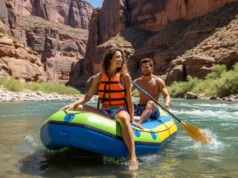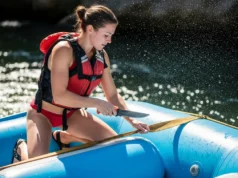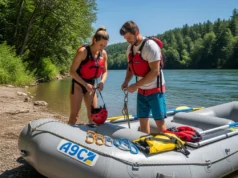In this article
In the chaotic, churning aerated water of a Class IV rapid, the last thing you should be thinking about is your life jacket. It shouldn’t ride up, restrict your paddle stroke, or feel like a bulky cage. Your Personal Flotation Device (PFD) is your silent partner in safety, a critical piece of whitewater safety gear so ideally comfortable you forget it’s there. This guide is designed to cut through the noise, demystifying the flotation science and matching the industry’s top-performing PFDs—from versatile Type III PFDs to specialized Type V rescue vests—to the four key types of river runners, ensuring your next life vest is a perfect, life-saving fit.
- Learn the five non-negotiable criteria for evaluating any whitewater PFD, from fit and mobility to durability.
- Understand why higher flotation isn’t always better and how to match buoyancy to your specific river class.
- Discover our top PFD picks for 2025, a comparison listicle specifically curated for four distinct user personas: The Professional Guide, The Expedition Rafter, The Performance Paddler, and The Raft Angler.
- See how our transparent testing process ensures every recommendation is based on objective performance and real-world use.
How to Choose the Right Rafting PFD: An Expert’s Framework
For selecting the optimal PFD, you need to stop thinking like a consumer and start thinking like an informed buyer. This framework gives you the objective knowledge to do just that, turning a complex decision into a clear one.
Why are Fit, Comfort, and Mobility the Most Critical Factors?
A PFD’s most advanced rescue features and highest US Coast Guard Rating are utterly useless if it’s worn incorrectly—or worse, not worn at all because it’s too uncomfortable. A proper fit is the foundation of its performance. Learning how to fit a PFD correctly starts with the “ride-up” test: with the vest fully tightened, have a friend lift up on the shoulder straps. If the PFD moves up past your chin, it’s too loose or the wrong size. A correctly fitted vest will stay locked onto your torso, ensuring it can’t be pushed up over your head during a turbulent swim in the rapids.
This secure, “locked-in” feel is achieved through multiple adjustment points. Typically, you’ll find six to eight adjustable straps at the shoulders, sides, and waist. By tightening these in sequence, you can create a customized fit that hugs your body without restricting your breathing. For dynamic activities like whitewater rafting, comfort features extend to mobility. Look for PFDs with articulated foam panels, often made from soft, PVC-free Gaia foam or organic kapok foam. These designs, sometimes featuring a high-cut design for better movement, allow the PFD to move with your body, bending and flexing as you paddle, swim, or pull yourself back into the raft. We also see specialized fits, like women’s-specific PFDs with a unique women’s fit, which use features like a princess-seam fit to provide a much more secure and comfortable experience for a wider range of body types.
Pro-Tip: To achieve the best fit, always tighten your PFD straps in order from the bottom up. Start with the waist belt to set the PFD’s position on your torso, then adjust the side straps for a snug feel, and finally, tighten the shoulder straps to take up any remaining slack. This prevents the vest from riding up from the start.
Once you have a secure and comfortable fit, the next step is to ensure the PFD has the performance to match the environment.
How Much Buoyancy Do You Really Need for Whitewater?
The US Coast Guard mandates a minimum of 15.5 pounds of design flotation for a standard adult Type III PFD, but this number is based on calm waters. Whitewater presents a completely different challenge. The water in a rapid is highly aerated—it’s “bubbly” water that is significantly less dense than flat water. This reduced density diminishes your PFD’s effective buoyancy, meaning you won’t float as high.
This is why “high-flotation PFDs,” those offering 22 pounds of buoyancy or more, are a critical safety advantage in powerful, aerated currents. The extra lift counteracts the force of the river, reducing the time underwater a swimmer spends and keeping their head higher for better breathing and visibility. For most recreational paddlers on Class III or lower-volume Class IV rivers like the Arkansas River, a standard or low-flotation PFD with 15.5 to 18 pounds of buoyancy is perfectly adequate. However, for guides, safety boaters, or anyone running big-volume, technical waters like the Futaleufu River or the Main Fork of the Salmon River, a high-flotation PFD provides a margin of safety that cannot be overlooked.
With a clear understanding of these core principles, let’s look at how we applied them to find the best PFDs on the market. For more information on official USCG standards, you can visit their official selection guide.
Our Selection Process: How We Built This Guide
Our mission is to build absolute trust with our readers. We achieve that by being completely transparent about our rigorous research and curation process, ensuring that every one of our contextualized recommendations is earned, not just given.
Our commitment to objectivity is paramount. This guide is the result of a comprehensive market analysis, not just personal opinion. We synthesized data from three key sources: feedback from professional raft guides who use this gear daily, in-depth expert gear reviews from trusted industry publications, and official Coast Guard PFD designations.
Every single PFD we considered was judged against the five critical criteria established in our framework: 1. Fit, Comfort & Mobility, 2. Safety & Buoyancy Performance, 3. Features & Organization (pockets, lash tabs), 4. Durability & Construction (assessing shell fabric denier and reinforcement), and 5. Value within its price range.
From a long list of over 30 popular PFD models, we began the filtering process. We identified the distinct user personas within the rafting community—from the beginner rafter to the experienced guide—and matched each product’s core strengths to the specific needs of that group. This ensures that every recommendation is purposeful and directly serves a real-world rafting discipline.
A Note on Affiliate Links: If you purchase a PFD through one of our links, we may earn a small commission at no extra cost to you. This helps support our work, but our recommendations are always driven by performance and user needs first.
The Best Rafting PFDs of 2025: Our Top Recommendations for Every Need
We’ve done the research and testing to present our curated top recommendations. Here are the best PFDs for the key rafting personas, designed to empower you to make your final selection with confidence.
Our Top Picks for “The Professional Guide & Safety Boater”
This user is an experienced rafter/guide who needs a Coast Guard Approved, USCG Type V Rescue PFD with bombproof durability, high flotation, and superior organization for carrying a full rescue kit. This PFD must include a quick-release rescue harness for swiftwater rescue scenarios where specialized training is required. Safety and performance are non-negotiable.
Our Top Picks for “The Private Expedition Rafter”
This experienced private boater needs a PFD that offers an optimal balance of all-day comfort for multi-day expeditions, robust durability, and practical features for storage without the complexity of a full rescue vest. Their ideal whitewater PFD is typically a high-end Type III personal flotation device.
Our Top Picks for “The Performance-Focused Paddler”
This athletic rafter values agility and freedom of movement above all else. They need a minimalist, low-profile PFD that feels like a second skin and won’t interfere with powerful paddle strokes during whitewater paddling. Their choice often comes down to the entry style they prefer: side-entry for a clean front panel or pullover for ultimate security.
Our Top Picks for “The Dedicated Raft Angler”
This user’s PFD is a wearable tackle management system, their primary piece of river gear for fishing from a raft. They require specialized, fishing-centric storage and a design (high-back or thin-back) that is comfortable in a seated position for long durations. Key features for this paddler include a mesh back for seat compatibility and numerous mounting points for tools.
Pro-Tip: When choosing a fishing PFD, pay close attention to the pocket layout and attachment points. Before you buy, mentally place your essential gear—fly box, pliers, nippers, tippet spools—on the vest. A well-designed fishing PFD keeps everything you need organized and accessible with one hand, minimizing movement that could spook fish.
Conclusion
- Fit is Paramount: A PFD that is uncomfortable or rides up is a dangerous PFD. Always prioritize a secure, articulated fit.
- Match Buoyancy to the Water: Standard flotation (15.5-18 lbs) is sufficient for most rafting, but big-volume, aerated whitewater demands high-flotation (22+ lbs) for a greater margin of safety.
- Choose for Your Role: Your needs as a guide, expedition boater, or angler are unique. Select a PFD with features—like a rescue harness, a large pocket, or a high-back design—that directly support your primary activity on the river.
- Call to Action (CTA): Investing in the right PFD is an investment in your safety and enjoyment on the water. Use this guide to choose the model that best fits your river style, and paddle with confidence on your next adventure.
Frequently Asked Questions about Rafting PFDs
What is the difference between a Type III and a Type V PFD for rafting?
The core difference between a Type III vs Type V PFD lies in their intended use. A Type III PFD is a standard “flotation aid” designed for comfort and mobility where a swift rescue is likely. It’s the standard for recreational rafting. A Type V PFD is a “special use device,” which in whitewater almost always refers to a Rescue PFD. The defining feature is an integrated quick-release rescue harness system designed for technical rescues. If you are a trained professional who needs a harness, choose a Type V PFD like the Astral GreenJacket. For all other recreational rafting, a Type III like the Kokatat Hustle is the appropriate and safer choice.
Do I really need a high-flotation PFD?
While not always required, a high-flotation PFD (22+ lbs) is strongly recommended for challenging Class III-V rivers. Aerated, “bubbly” water is less buoyant, and the extra lift from a high-flotation vest helps you surface faster and keeps your head higher out of the water. For boaters who frequent these powerful waterways, a vest like the Astral Indus provides a significant, potentially life-saving, safety advantage. For most recreational paddlers on calm or less-demanding rivers, standard flotation is sufficient.
Can I use a fishing PFD for regular whitewater rafting?
Yes, you can absolutely use a well-fitting fishing PFD for recreational whitewater rafting, as they meet the same Type III safety standards for flotation and performance. However, be aware of the trade-off. The numerous pockets, tool holders, and attachment points on models like the NRS Chinook can create potential snag hazards in a serious swim. If your primary activity is rafting and you only fish occasionally, a more streamlined, low-profile PFD might be a better choice.
Do I need a rescue PFD if I’m not a guide?
You should only purchase and use a Type V Rescue PFD if you have professional swiftwater rescue (SWR) training. The quick-release rescue belt and other hardware are specialized tools that, if used improperly, can be extremely dangerous. For untrained users, the extra webbing and buckles on a rescue PFD can become a serious entanglement hazard. A standard Type III PFD is the safer and more appropriate choice for all non-rescue-trained rafters.
Risk Disclaimer: Whitewater rafting, kayaking, and all related river sports are inherently dangerous activities that can result in serious injury, drowning, or death. The information provided on Rafting Escapes is for educational and informational purposes only. While we strive for accuracy, the information, techniques, and safety advice presented on this website are not a substitute for professional guide services, hands-on swiftwater rescue training, or your own critical judgment. River conditions, including water levels, currents, and hazards like strainers or undercut rocks, change constantly and can differ dramatically from what is described on this site. Never attempt to navigate a river beyond your certified skill level and always wear appropriate safety gear, including a personal flotation device (PFD) and helmet. We strongly advise rafting with a licensed professional guide. By using this website, you agree that you are solely responsible for your own safety. Any reliance you place on our content is strictly at your own risk, and you assume all liability for your actions and decisions on the water. Rafting Escapes and its authors will not be held liable for any injury, damage, or loss sustained in connection with the use of the information herein.
Affiliate Disclosure: We are a participant in the Amazon Services LLC Associates Program, an affiliate advertising program designed to provide a means for us to earn advertising fees by advertising and linking to Amazon.com. As an Amazon Associate, we earn from qualifying purchases. We also participate in other affiliate programs and may receive a commission on products purchased through our links, at no extra cost to you. Additional terms are found in the terms of service.





